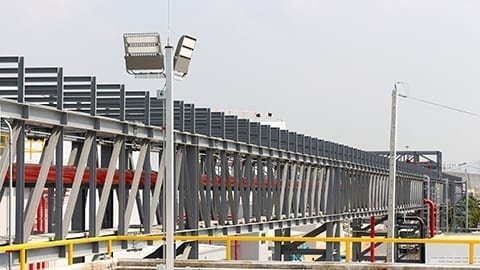
Solar lighting is currently a $5 billion industry and is expected to double by 2024. Solar lighting is adapting to the growing market, offering fixtures with battery technology and programmable options to lengthen the life of a single charge. Programable options such as timers, motion sensors, daylight sensors and dimming lights further extend a single charge. Not only are products better, but customers are seeing more return for their investment. In addition to electrical and construction costs, the government offers a 26% tax credit on the cost of the system and many states offer additional solar rebates and incentives.
While solar power is frequently used to light gardens and landscape, the technology has been improved to expand its use to other areas, pathway lighting, free standing fixtures and security lights. Solar lights can be especially beneficial to illuminate areas not currently connected to the power grid. Solar panels harness and store energy in photo voltaic cells. Solar panels can be built into or separate from the fixture, making the application of solar lighting limitless. As long as the solar panel has access to sunlight, energy will be harnessed and stored to power the lights. Modern technology has both expanded application and improved functionality. Lights shine brighter and last longer with a battery life of 5–7 years. When choosing the right lighting, there are many factors to consider.
Function and Light Quality
Depending on your lighting needs, there are several options available. Solar lighting can be used to accent a pathway, or it can be used to illuminate large areas, such as streets or yards. If you have a variety of needs, you may want to consider purchasing solar lighting with a dimming feature. If you wish to conserve energy, opt for lighting with an automatic timer or motion sensor so the lights turn on when you need them most.
In addition to power of light, the color of light is also a factor. Most solar light fixtures have LED lights; however, if you want a more natural light, this might not be the best option. To soften the light, consider purchasing fixtures with colored glass panels.
Location
Solar lighting has limitless application. Fixtures can be installed in the ground, from walls, hung from trees or even installed as free-standing fixtures, such as light posts. For example, a string of lights may be used to accent a tree. Or if you are seeking security, install a flood light high above a doorframe to provide maximum light. Wherever you place your lights, ensure the solar panel has adequate sunlight to gather the necessary power. If there is not good exposure to sunlight where you place your lights, you may want to consider an external solar panel placed in a well-lit area and wired back to the light fixture.
Climate
Tropical climates often have no issues harnessing enough energy, whereas those in diverse or overcast climates may notice solar batteries do not charge as efficiently. Weather has a large impact on the effectiveness of both the battery and LED lights in a solar light fixture. LED lighting functions in temperatures as extreme as -40 degrees while current battery technology only withstands temperatures as low as -2 degrees. However, technology is continually improving. When selecting solar lighting fixtures, research the optimum temperature range for both batteries and lights, selecting the toughest, most efficient light for your location.
Efficiency and Cost Savings
Most small lights will harness enough energy to run for 6–8 hours. Higher powered lights will need more sunlight to gather the necessary energy to run. While gathering solar energy is free, in order to observe significant impacts on your electricity bill, you will need to invest in an energy efficient circuit. It is also recommended to purchase a family of products which are designed to run together. This option is more expensive, but you will have more reliable and efficient lighting. Border States Lighting Specialists are available to identify the best options to suit your needs.
Pros and Cons of Solar Lighting
The four biggest factors to consider when switching to solar lighting are environmental, financial, efficiency and maintenance.
- Environmental – solar energy is an abundant, sustainable, low pollution, renewable resource. While solar power itself is green, it can only be harnessed half the day and batteries are required to provide power in the evenings and on cloudy days. Harmful chemicals are often used to produce batteries.
- Financial – equipment and materials for solar lighting can be costly; however, return on investment is guaranteed. Solar energy can save up to 76% on power consumption and you will recover your investment within 5 years. Additionally, tax credits are offered for going solar and if you harness more energy than you need, you can sell this power back to the grid.
- Efficiency – solar lighting systems are simple to install, they are easily transported and they can bring power to remote locations. However, solar energy only works with access to sunlight and depending on energy needs, a back-up connection to the power grid may still be required.
- Maintenance – solar lighting is relatively low maintenance. Routine upkeep is as simple as removing obstructions from panels or changing a battery. However, if professional maintenance is required, it can be costly.
Border States has experienced Lighting Specialists who can help you determine if solar lighting is the right option for your project. Find a Border States location near you.